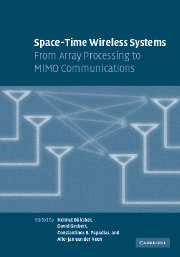Book contents
- Frontmatter
- Contents
- List of contributors
- Acknowledgments
- Introduction
- Part I Multiantenna basics
- Part II Space-time modulation and coding
- Part III Receiver algorithms and parameter estimation
- Part IV System-level issues of multiantenna systems
- Part V Implementations, measurements, prototypes, and standards
- 23 What we can learn from multiantenna measurements
- 24 Experiments in space-time modulation and demodulation
- 25 Multiple antenna techniques in 3G wireless systems
- 26 MIMO wireless local area networks
- 27 VLSI implementation of MIMO detection
- Index
26 - MIMO wireless local area networks
Published online by Cambridge University Press: 25 February 2010
- Frontmatter
- Contents
- List of contributors
- Acknowledgments
- Introduction
- Part I Multiantenna basics
- Part II Space-time modulation and coding
- Part III Receiver algorithms and parameter estimation
- Part IV System-level issues of multiantenna systems
- Part V Implementations, measurements, prototypes, and standards
- 23 What we can learn from multiantenna measurements
- 24 Experiments in space-time modulation and demodulation
- 25 Multiple antenna techniques in 3G wireless systems
- 26 MIMO wireless local area networks
- 27 VLSI implementation of MIMO detection
- Index
Summary
Introduction: high throughput short range systems–from SISO solutions to new MIMO standards
Until recently, wireless local area network (WLAN) devices, heavily constrained in cost and size, have fulfilled short range communication needs with very simple spatial diversity schemes at the access points (AP) realized, in general, with two antennas. Now WLAN AP products embedding phased array antenna designs have been designed with the objective of extending the range of the WLAN coverage, especially outdoors. However, with the demand for increasing bit rate, and the limited amount of spectrum available, the application of multiple-input multiple-output (MIMO) techniques to WLAN has been identified as a key enabler for high throughput WLAN; as a consequence, for instance, all the proposals made to the IEEE 802.11n task group, created in 2004 with the objective of devising next generation WLAN, include MIMO processing of the data.
The objective of this chapter is to present a design methodology for WLAN air interfaces relying on multiantenna signal processing solutions, and meeting feasibility requirements in terms of bit rate, bandwidth, and complexity. Here, we limit ourselves to a design compatible with the requirements set by the IEEE 802.11n task group: the aim is to provide a peak throughput of at least 100 Mbps at the medium access control (MAC) data service access point (SAP). Thus, with an overall MAC efficiency of 80%, thanks to a carefully optimized MAC, the peak physical (PHY) data rate of the designed WLAN systems should be at least of 125 Mbps.
Information
- Type
- Chapter
- Information
- Space-Time Wireless SystemsFrom Array Processing to MIMO Communications, pp. 531 - 553Publisher: Cambridge University PressPrint publication year: 2006
